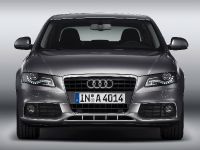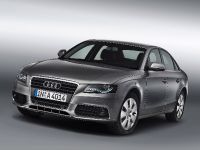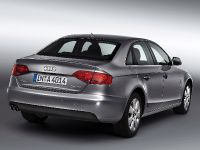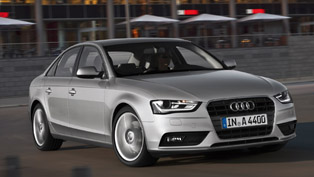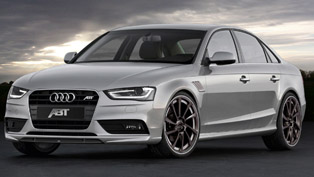Audi A4 TDI concept e
Efficiency is the way into the future – Audi is introducing the current state-of-the-art for its fuel-saving technologies at the Paris Auto Show. The A4 TDI concept e technology concept has the agile handling characteristics typical of the A4, but requires just 3.99 liters of fuel per 100 kilometers (58.95 US mpg). This exemplary result was possible through the concentrated use of innovative efficiency modules.
Audi is committing major resources in order to continue improving fuel efficiency and reducing emissions. The brand is introducing a trend-setting technology concept at the Paris Auto Show: the A4 TDI concept e offers the typically agile experience of driving an Audi, yet it uses just 3.99 liters of fuel per 100 km (58.95 US mpg), which corresponds to a CO2 output of only 105 grams per km (168.98 g/mile). With this near-production study, Audi demonstrates the great potential of the technologies in its modular efficiency system.
The powertrain of the Audi A4 TDI concept e uses a direct-injection TDI engine with an output of 88 kW (120 hp) and 290 Nm (213.89 lb-ft) of torque. It propels the sedan from 0 to 100 km/h (62.14 mph) in 10.7 seconds, and tops out at 206 km/h (128 mph). An entire array of details – from soft springs on the intake valves to a new thermal management system – improves fuel efficiency. Intelligent technologies are used in the engine's functional environment as well, such as on the fuel pump and on the automatic air conditioning's compressor.
The recuperation system is another fundamental component for improving fuel efficiency. It recovers power when braking and coasting to a stop, and temporarily stores it in a battery. A start-stop system switches the engine off when the vehicle comes to a standstill. Magnesium was used to reduce the weight of the six-speed transmission, which received an insulating cover for faster warm-up and modified gear ratios.
Audi uses an electromagnetic servo assembly for steering; electrically actuated brakes are fitted at the rear. The 225/45 R17 tires have been optimized for road resistance. Sophisticated fine-tuning measures have improved the aerodynamics of the body. Two types of support are at the driver's fingertips: he can either call up an economy training program, or have the navigation system calculate the most fuel-efficient route to his destination.
At a glance
Engine
- Two-liter TDI with displacement of 1,968 cc, 88 kW (120 hp) output and 290 Nm (213.89 lb-ft) of torque
- Average consumption only 3.99 liters/100 km (58.95 US mpg), corresponds to 105 grams of CO2/km (168.98 g/mile)
- 0 – 100 km/h (62.14 mph) in 10.7 seconds, top speed: 206 km/h
- Intelligently controlled subassemblies and additional new engineering
- Recuperation system for recovering energy when braking
Drivetrain
- Six-speed manual transmission with magnesium housing, adapted gear ratio and insulation all the way around
- Automatic start/stop for switching off the engine when it has come to a standstill
Chassis
- Power steering with highly efficient electro-mechanical drive
- Electrical brake system on the rear axle
- Road-resistance-optimized using 225/50 R17 tires
Body
- Sophisticated aerodynamic fine-tuning with rear trailing edge
and partially closed single-frame grille, aero-floor and modified ride height
Interior
- Economy training program on the instrument panel display
- Navigation system with calculation of the most fuel-efficient route
The engine
The heart of the sedan is a direct-injection diesel engine – a 2.0 TDI with output of 88 kW (120 hp), just as for the A4 production models. From 1,750 to 2,500 rpm, the four-cylinder engine produces a constant torque of 290 Nm (213.89 lb-ft), which generates impressive acceleration. The piezo injectors in the common-rail system inject the extremely finely atomized fuel at a pressure of up to 1,800 bar, and the special piston geometry provides ideal thermodynamics in the combustion chambers.
The 2.0 TDI also features a comprehensive package of additional efficient technologies. The oil cooler, the oil nozzles for cooling the piston crowns, the oil pump and the water pump have been designed so that they can be switched off – when inactive they do not require any power. New piston rings resulted in lower tangential forces, the spring pressure on the intake valves was reduced slightly, and the vacuum pump for the brake booster received a new actuator. These measures as a whole reduce emissions by 5 grams of CO2/km.
Other engine-related modifications include reduced internal friction, a new thermal management system during the warm-up phase and an electronically controlled fuel pump.
Just as in the production version, Audi is using a thermostatically controlled cooling circuit with an internal heat exchanger for the automatic air conditioning system. It responds in a highly efficient manner – the system uses 20 percent less fuel than its predecessor. The A4 TDI concept e uses a new controller: the engine disconnects the air conditioning system's compressor from its drive whenever possible.
Like many Audi production models, the A4 TDI concept e uses a recuperation system that converts the energy of motion during deceleration into usable electrical energy. In the deceleration and braking phases the A4 TDI concept e operates with increased secondary voltage. At this point, it is able to convert the kinetic energy into electrical energy; it is buffered in an absorbent glass mat battery, which is a robust battery with a long life. Whenever the sedan accelerates again, the battery feeds the energy back in, thus reducing the load on the alternator.
Efficiency and agility are inextricably linked at Audi – as proved by the basic data for the A4 TDI concept e. The sedan sprints from 0 to 100 km/h (62.14 mph) in 10.7 seconds, and accelerates from 80 to 120 km/h (49.71 to 74.56 mph) in fifth gear in just 10.9 seconds. The A4 TDI concept e reaches a top speed of 206 km/h (128 mph).
Drivetrain and chassis
The 2.0 TDI transfers its power to a six-speed manual transmission which is notable for its considerably reduced internal friction. It was specially customized to the high-torque TDI engine and has somewhat taller ratios for gears three through six. Most of the housing consists of ultra-light magnesium, which reduces weight by nearly 5 kilograms. A foam-packed skin serves as insulation, ensuring that the transmission oil heats up faster after the vehicle has been started. The drive shafts from the differential to the front wheels have also been redesigned.
The transmission is coupled to a start-stop system that switches the engine off whenever the sedan comes to a standstill. The TDI is deactivated whenever the A4 TDI concept e comes to a standstill, the shift lever is in the neutral position, and the driver's foot is off the clutch pedal. It starts up again as soon as the driver steps on the clutch – a specially developed starter handles this in around two tenths of a second, which is faster and smoother than a traditional component. While the driver puts the vehicle in gear, the TDI speeds up; as he takes his foot off the pedal, it drops down to idle speed.
The start-stop system improves the exemplary fuel efficiency of the Audi A4 TDI concept e still further, meaning that 5 grams less of CO2 are produced per 100 kilometers – as measured on the dynamometer. And in actual terms this reduction may turn out even higher, as many trips to work are less than ten kilometers long and are frequently interrupted by traffic lights.
Another important feature is that an electro-mechanical part replaced the electro-hydraulic power steering. This yielded a further reduction of 4 grams of CO2/km. It does not have to circulate any hydraulic fluid, nor absorb any energy while the vehicle is traveling in a straight line – its electric motor which provides power assistance only kicks in if the driver turns the wheel.
The electrical brakes are another technology module that shows how meticulous the Audi engineers were in their approach to efficiency. Thanks to active brake control, residual brake torque is almost non-existent. It only arises if the small air gap that is necessary for a stiff feel to the pedal and immediate brake response results in a slightly unevenly shaped disk rubbing on the lining. Using electrical rear-axle brakes will achieve the same effect on the front axle: here, an enlarged air gap is also possible since the power brake system only has to carry out the lining displacement for one axle.
Body and cockpit
The A4 TDI concept e glides sleekly through the wind. A trunk lid with a restrained separating edge adds a further dimension to the already excellent aerodynamics. The partially closed grid in the single-frame grille and sporty suspension tuning with optimized ride height also contribute to the excellent drag coefficient of 0.25 (production model: 0.27).
The underbody of the technology study painted in Daytona Grey is faired much more extensively than the production model; the rear lights feature LED technology, which uses much less power than regular bulbs. Newly designed, dip-polished cast aluminum wheels, of the size 7.5 J x 17 improve the flow of air around the wheels and wheel housings. The tires are designed for smooth running, but also provide sporty grip due to their 225/50 R17 wide format.
The intricate technology package from Audi's modular efficiency system also takes the most important external factor of all into account as far as possible: the person behind the wheel. Despite the prominence of high-end technology, the driver remains primarily responsible for how fuel-efficient his vehicle is. This is a fact that Audi takes very seriously in relation to its efficiency strategy.
The driver will discover two major aids in the A4 TDI to help him drive economically. He can call up an efficiency program that shows up on the instrument panel display and which acts like an ecology trainer – pointing out open side windows or recommending rapid upshifting. And the navigation system will always offer an especially fuel-saving route as an alternative whenever the driver enters a destination.
The ‘e' models from Audi
The Audi ‘e' models are especially progressive, combining maximum efficiency with excellent dynamics. The Audi A3 1.9 TDI e and the A3 1.9 TDI e Sportback both achieve standardized fuel efficiency figures of 4.5 liters per 100 km (52.27 US mpg) and a CO2 value of only 119 grams per km (191.51 g/mile). Both models have an output of 77 kW (105 hp) and a top speed of 194 km/h (120.55 mph).
The new Audi A6 2.0 TDI e and its Avant equivalent are equipped with a 100 kW (136 hp) diesel. The sedan accelerates from 0 to 100 km/h (62.14 mph) in 10.3 seconds and has a top speed of 208 km/h (129.25 mph). Average fuel consumption for both models: only 5.3 l/100 km (44.38 US mpg).
The A8 2.8 FSI e, with its 154 kW (210 hp) V6 on average consumes only 8.3 liters of fuel (28.34 US mpg), making it the most efficient gasoline engine in the luxury class.
Audi plans to expand its ‘e' model line in the near future and start putting further technologies from its modular efficiency assembly into production. By the year 2012, the brand with the four rings will once again have significantly reduced CO2 emissions while continuing to hone its sporty, elegant profile.
